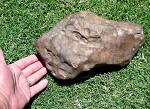Stones represent the third main group of meteorites, by far the most diverse group of the three. Nine out of ten meteorites that fall from the sky are stone meteorites. Fewer are found, however, primarily because they resemble Earth rocks, and are therefore harder to recognize. Stone meteorites also decompose more rapidly under terrestrial conditions than irons.
Stone meteorites are divided into two main groups; those with chondrules, the chondrites and those without, the achondrites. Chondrules, from the Greek word for “seed”, are the inclusions for which the two types are named. These round spheres of silicates range in size from the microscopic, to the size of marbles. Most, however, are the size of steel shot pellets. These chondrules are time-travelers, dating from the very beginnings of the solar system, some 4.6 billion years ago.
Formed as clouds of pre-solar dust began to condense, these tiny balls were packed into larger and larger masses, eventually forming small moons and asteroids. Some of the “parent bodies” were destroyed before they accumulated enough matter to cause re-melting of their core material. Bits of this material usually contains chondrites in their earliest form.
Other parent bodies continued to accrete material until the mounting high-pressures within destroyed all evidence of the original chondritic structure. Bits of this material represent the achondrites, or those without chondrules. Gao
Gao
more…
Achondrites
Chondrites